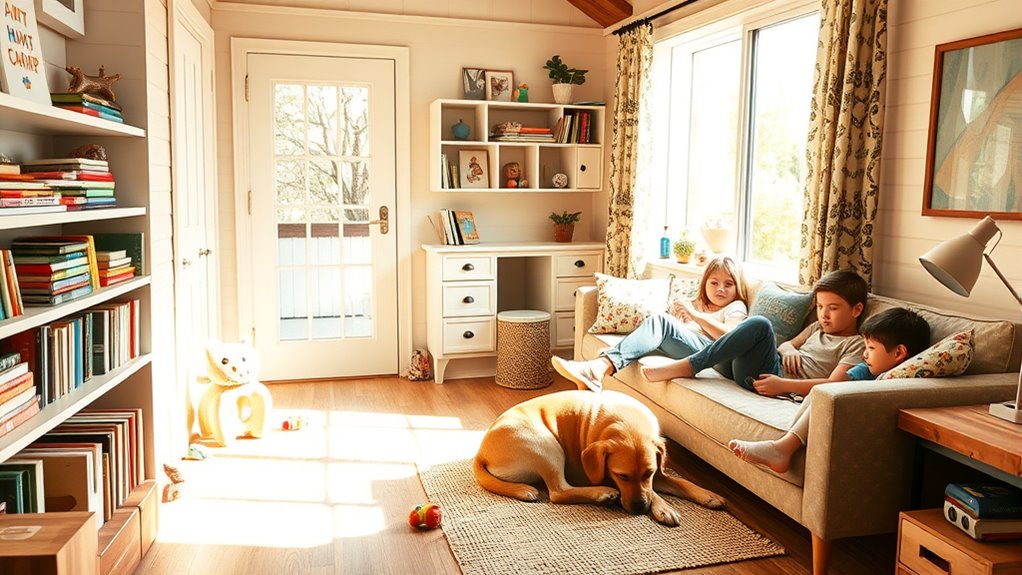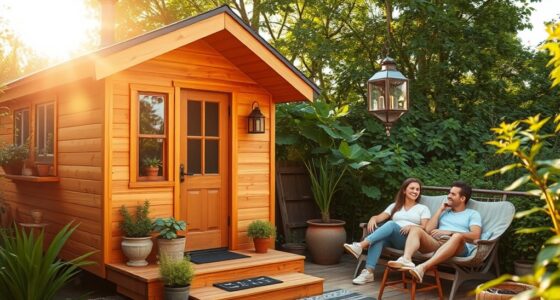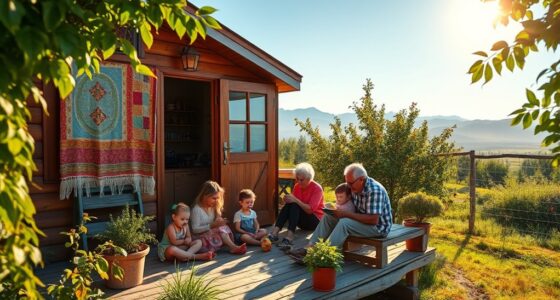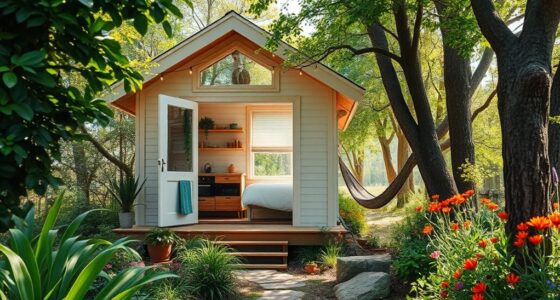Living in a tiny home with kids and pets means you’ll need clever space management and outdoor zones to stay organized and comfortable. Use multipurpose furniture, vertical storage, and outdoor areas for play, relaxation, and extra storage. Creating designated activity zones keeps clutter at bay and encourages family bonding. Shaping your outdoor spaces with weatherproof furniture and outdoor storage helps extend your living area. Keep exploring for more tips on making this lifestyle enjoyable and functional for everyone.
Key Takeaways
- Implement smart, multipurpose storage solutions to keep clutter free and maximize limited space for kids and pets.
- Design dedicated outdoor zones for play, relaxation, and outdoor dining to expand living areas and reduce indoor clutter.
- Use weatherproof outdoor storage for seasonal items, pet gear, and toys to maintain an organized indoor environment.
- Create versatile outdoor spaces with shaded zones or pergolas for year-round outdoor activities and family bonding.
- Prioritize durable, easy-to-maintain furniture and involve children and pets in organization for a harmonious tiny home life.

Living in a tiny home with kids and pets can be both a rewarding and challenging experience. Every inch of space counts, so you need smart storage solutions that keep clutter at bay while still allowing everyone to feel comfortable. Multipurpose furniture becomes your best friend—think beds with built-in drawers, fold-away tables, or ottomans that hide toys and supplies. Vertical storage is also essential; wall-mounted shelves or hooks help free up floor space and keep essentials within reach. Utilizing under-stair storage or cabinets above doorways can maximize every available inch. With limited space, it’s crucial to involve your kids and pets in maintaining organization, teaching them to put things back and respect shared areas. This ongoing effort helps keep your tiny home functional and cozy.
Outdoor living becomes a vital extension of your home. When indoors feels tight, creating a dedicated outdoor area offers relief and additional space for play, relaxation, and even dining. A small patio, a garden, or a porch can serve as a versatile spot where kids can run around freely and pets can play safely. Consider adding outdoor furniture that’s durable and easy to clean, like foldable chairs or a compact table for family meals outside. Incorporate outdoor storage solutions like weatherproof bins or cabinets for garden tools, toys, and pet accessories. This setup not only helps keep your indoor space uncluttered but also encourages outdoor activities that everyone can enjoy together. Think about creating shaded zones or installing a pergola to make outdoor living comfortable regardless of weather.
Balancing indoor and outdoor spaces requires some planning, especially when it comes to storage solutions. Use outdoor storage to hold seasonal items, sports equipment, or pet supplies, freeing up indoor space for daily essentials. You might also set up dedicated zones for different activities—play areas for the kids, a cozy corner for reading, or a small garden patch for growing herbs and veggies. This organization makes it easier to maintain a peaceful, functional environment amidst the chaos of family life. Additionally, exploring best beaches in your region can provide inspiration for outdoor living and recreation spaces, blending your tiny home lifestyle with nearby natural beauty. Remember, the goal is to make your tiny home a sanctuary where everyone feels at ease, and that often means extending your living space outdoors. With thoughtful storage solutions and a focus on outdoor living, you create a flexible, inviting home that accommodates your family’s needs while celebrating the joys of small-space living.
Frequently Asked Questions
How Do You Handle Privacy in a Tiny Home With Kids and Pets?
To handle privacy concerns in a tiny home with kids and pets, you set clear boundaries for everyone. Use room dividers or curtains to create separate spaces, especially for sleeping and quiet time. Establish pet boundaries to keep them out of certain areas. Encourage respectful privacy habits, like knocking before entering. This way, everyone gets some personal space, and privacy concerns are minimized, making your tiny home more comfortable and harmonious.
What Safety Measures Are Essential for Kids and Pets in Small Spaces?
Did you know that small spaces increase fire hazards by 30%? To keep your kids and pets safe, you should prioritize fire safety by installing smoke alarms and keeping fire hazards away. Pet proofing is essential—use child-proof latches on cabinets and secure cords. Always supervise your little ones and pets, and create designated safe zones. These measures help prevent accidents and guarantee a secure environment in your tiny home.
How Do You Organize Storage for Toys and Pet Supplies?
You organize storage for toys and pet supplies by using decorative storage bins that blend seamlessly with your decor. Opt for multifunctional furniture, like ottomans or beds with built-in compartments, to maximize space. Keep frequently used items accessible, while seasonal or less-used toys and supplies go into less prominent spots. Regularly declutter to maintain order, making your tiny home functional and inviting for everyone.
What Are the Best Ways to Manage Noise Levels?
To manage noise levels, you should use soundproofing techniques like adding rugs, curtains, and weatherstripping to minimize sound transfer. Incorporate noise-canceling devices such as white noise machines or earplugs to block out disruptive sounds. Encourage quiet zones during certain hours and establish routines for noisy activities. These strategies create a peaceful environment, helping everyone, including kids and pets, feel more comfortable in your tiny home.
How Do You Balance Work, Play, and Rest in Limited Space?
Research shows that multitasking routines boost productivity and well-being, so you can seamlessly balance work, play, and rest. Set designated zones for each activity, and incorporate outdoor activities to refresh your mind. Use a flexible schedule, allowing you to switch easily between tasks. Prioritize self-care, involve your kids and pets in simple activities, and create a routine that adapts to your family’s needs, ensuring harmony in your limited space.
Conclusion
Living in a tiny home with kids and pets keeps you busy, but it also teaches valuable lessons about simplicity and togetherness. Did you know that 78% of tiny homeowners report feeling more connected to their families? Despite the limited space, you find creative ways to make every inch count, creating a warm, lively environment. Embrace the chaos and cherish these moments—they’ll become your favorite memories in this cozy, bustling life.









